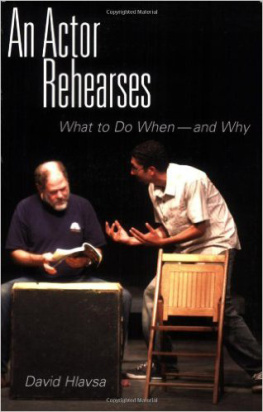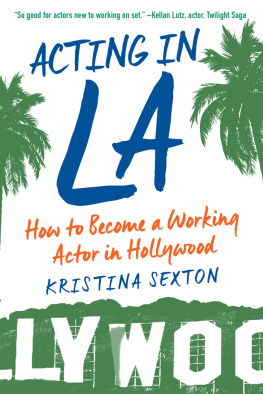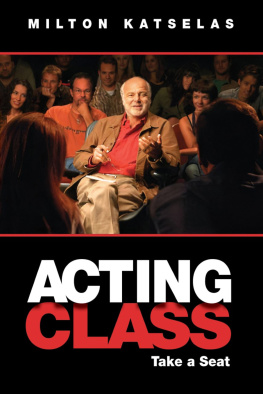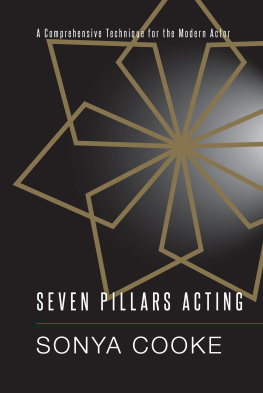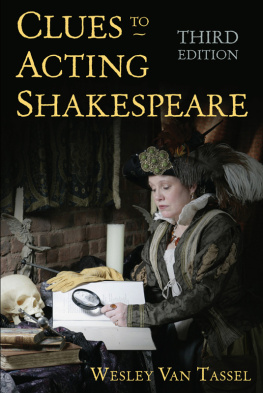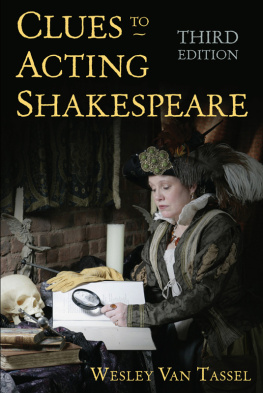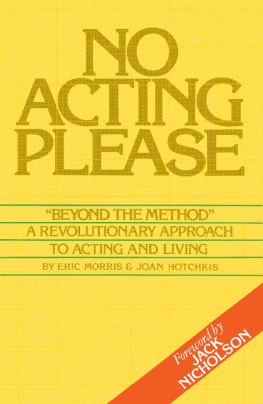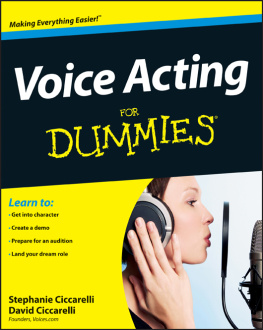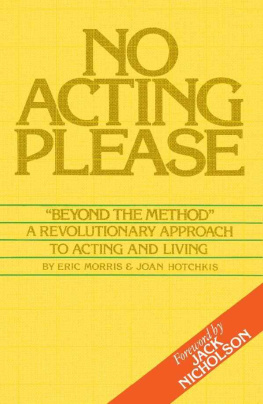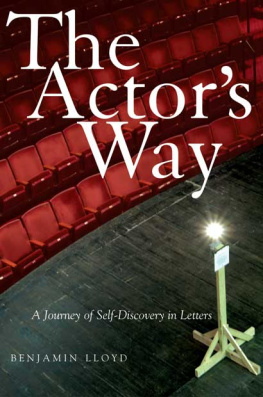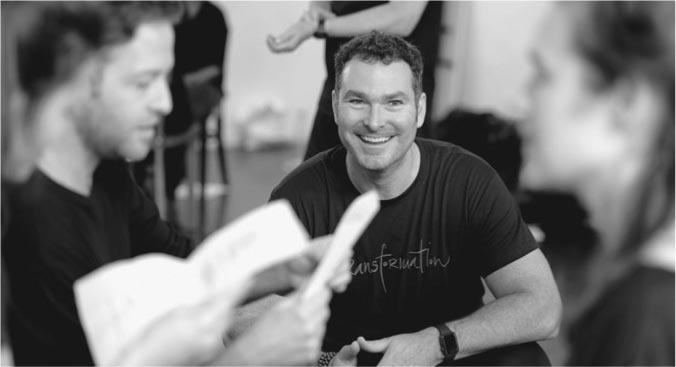
Author photo by Maurice Bender
Hugh OGorman is the author of The Keys to Acting. He is an actor, director, teaching artist, and coexecutive director of the National Alliance of Acting Teachers. Since 2002, he has been the head of acting at California State University, Long Beach. His acting credits include Broadway, Off-Broadway, and more than a dozen of the nations most respected regional theaters. His many television credits include AMCs Emmy Awardwinning show Remember WENN (SAG Award nomination) and HBOs John Adams. Hugh teaches acting in Los Angeles.

I must first acknowledge my sources for this material. I am deeply indebted to Earle Gister and Lloyd Richards for sharing not only this valuable material but also their invaluable gifts as teachers in their classes at the Actors Center in New York City as part of the indispensable and inspiring Teacher Development Program (TDP) now being offered by the National Alliance of Acting Teachers (NAAT). I also must humbly acknowledge J. Michael Miller, founding director of the Actors Center, for his years of unwavering mentorship, his belief in me as a teacher, and his encouragement to write this book. I also want to thank him for his heartfelt and insightful foreword to the book. I, too, wish to acknowledge the many other teachers and colleagues with whom I have studied acting and whose teaching has deeply affected my own practice, namely Jack Clay, Joanna Merlin, Ron Van Lieu, Viacheslav Dolgachev, Mala Powers, Mark Jenkins, Judith Dickerson, Max Dixon, Catherine Madden, Connie Haas, David Zinder, Alexandra Billings, Catherine Fitzmaurice, Randy Reinholz, Declan Donnellan, Ted Pugh, Fern Sloan, Lenard Petit, Jack Colvin, John Lehne, Vernice Klier, Sharon Marie Carnicke, my performance faculty colleagues at California State University Long Beach (CSULB), Ezra Lebank, Andrea Caban, Anna Steers, Simon Brooke, Sarah Underwood, Joanne Gordon, and Brian Mulligan. I would also like to acknowledge my coexecutive director of the NAAT, Amy Herzberg, with whom I attended Earles classes in the TDP, as well as the stalwart members of NAATs Executive Committee, the incomparable Michele Shay, Kenneth Noel Mitchell, Gerald Glackin, Peter Jay Fernandez, and Jane McPherson. I am also deeply indebted to all the students I have ever taught, from whom I certainly learned more than they from me; all the actors with whom I have ever shared the stage and screen, especially my beloved Remember WENN family; my cohorts in the TDP at the Actors Center from 2003 to 2008, especially Kimberly Ross; my dear, fellow travelers in MICHA, the Michael Chekhov Association, Jessica Cerullo, Dawn Arnold, Ragnar Freidank, Anne Gottlieb, Bethany Caputo, Scott Fielding, and Craig Mathers; MCE: Michael Chekhov Europe; Uli Meyer-Horsch; Suzana Nikolic, Jesper Michelsen, Sol Garre, Jobst Langhans, and Marjolein Baars, as well as all my esteemed colleagues in the NAAT, and my colleague in performance theory, Kevin Sverduk.
At Rowman & Littlefield Publishing, I humbly acknowledge the support, encouragement, and guidance of Carol Flannery, Michael Tan, Christen Karniski, Lara Hahn, and Niki Guinan, as well as the invaluable editorial assistance I received from my colleagues in the field of actor training, Jonathan Freeman, Kerrie Brown Seymour, and David Bridel. A generous and sincere bow of appreciation goes to Gary Palmer for his brilliant artistic interpretation of the space between; I am deeply honored to have his beautiful artwork grace the cover of this book. I also want to loudly acknowledge the herculean editorial assistance of the indefatigable Julia Martin on both in particular; and unwavering moral support. To all of these angels, I am eternally grateful.
By ourselves is evil done
By ourselves we pain endure
By ourselves we cease from wrong
By ourselves we become pure.
No one saves us but ourselves
No one can and no one may
We ourselves must tread the path
Teachers only show the way.
Dhammapada
Thank you, Mark. Love you, brother.
Aaron, Stephen. Stage Fright: Its Role in Acting. Chicago: University of Chicago Press, 1986.
Baldwin, James. The Fire Next Time. New York: Knopf Doubleday, Vintage International, 1992.
Barr, Anthony. Acting for the Camera. Rev. ed. New York: William Morrow Paperbacks, 1997.
Barton, Robert. Acting Reframes Using NLP to Make Better Decisions in and out of theTheatre. New York: Routledge, 2011.
Beckett, Samuel. Worstward Ho. New York: Grove Press, 1983.
Blair, Rhonda. The Actor, Image, and Action: Acting and Cognitive Neuroscience. New York: Routledge, 2008.
Borst, Gregoire, and Stephen M. Kosslyn. Visual Mental Imagery and Visual Perception: Structural Equivalence Revealed by Scanning Processes. Memory and Cognition 36, no. 4 (2008): 84962.
Bourdain, Anthony. Kitchen Confidential: Adventures in the Culinary Underbelly. New York: Bloomsbury USA, 2000.
Brown, Bren. The Power of Vulnerability. June 2010. TEDxHouston Talk. 20:04. https://www.ted.com/talks/brene_brown_the_power_of_vulnerability?language=en.
Carnicke, Sharon Marie. Stanislavsky in Focus: An Acting Master for the Twenty-First Century. 2nd ed. New York: Routledge, 2008.
. Teacher Development Program for the National Alliance of Acting Teachers. Los Angeles, 2017.
Charlie Rose. Aired April 27, 2009, on PBS.
Chekhov, Anton. The Three Sisters. 1901.
Chekhov, Michael. Lessons for the Professional Actor. Baltimore, MD: Performing Arts Journal Publications, Johns Hopkins University Press, 1985.
. Michael ChekhovsLessons for Teachers. Expanded ed. New York: MICHA, 2018.
. To the Actor: On the Technique of Acting. Rev. ed. New York: Routledge, 2002.
Colvin, Geoff. Talent Is Overrated: What Really Separates World-Class Performers from Everybody Else. New York: Penguin, 2008.
Csikszentmihalyi, Mihaly. Flow: The Psychology of Optimal Experience. New York: Harper Perennial, 1990.
Dolgachev, Viaslav. Teacher Development Program, Actors Center and the National Alliance of Acting Teachers. New York City and Los Angeles, 20032006, 2008, 20172018, 2020.
Donnellan, Declan. The Actor and the Target. St. Paul, MN: Theatre Communications Group, 2002.
Duhigg, Charles. The Power of Habit: Why We Do What We Do in Life and Business. New York: Random House, 2012.
Dweck, Carol. Mindset: The New Psychology of Success. New York: Ballantine Books, 2007.
Epstein, David. Range: Why Generalists Triumph in a Specialized World. London: Pan MacMillan, 2019.
Ericsson, K. Anders, Ralf Th. Krampe, and Clemens Tesch-Romer. The Role of Deliberate Practice in the Acquisition of Expert Performance. Psychology Review 100, no. 3 (1993): 363406.
Esper, William, and Damon DiMarco. The Actors Art and Craft: William EsperTeaches the Meisner Technique. New York: Anchor Books, 2008.
Fannin, Jim. Life in the Zone. S.C.O.R.E. Performance Systems, 2007. CD.


